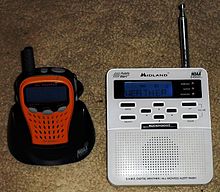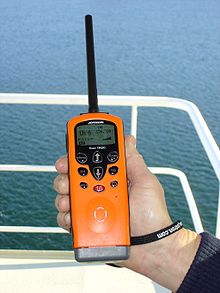Weatheradio Canada
Weatheradio Canada (French Radiométéo Canada ) is a Canadian radio network that continuously transmits weather information for Canada and the Canadian sea areas. The system is operated by the Meteorological Service of Canada , a division of Canada's Ministry of the Environment, Environment and Climate Change Canada . The reports will be sent in both official languages, first in English and then in French. The network operates 230 own VHF - transmitter . In addition, it uses the Canadian Broadcasting Corporation's AM and FM transmitters , especially in sparsely populated areas. In addition to Weatheradio Canada, the Canadian Coast Guard also operates stations that broadcast weather reports.
program
Current weather reports and forecasts are broadcast continuously. The broadcasts are generated automatically with a text-to-speech system . Warning messages are introduced and ended by special digital characters. These characters enable receivers that are normally muted to be switched to receive when these characters are received. This procedure was developed by the American NOAA as part of the Emergency Alert System and is called Specific Area Message Encoding (SAME). For example, radio stations can automatically import these warning messages into their current program. But private households can also be warned of storms and other dangers without having to listen to the broadcasts all the time. The system is comparable to the European traffic information. In order to be able to test the functionality of the receivers, test broadcasts take place regularly, usually on Wednesdays between 11.50 a.m. and 12 noon. The alarm tone (1050 Hertz) is also triggered once a month.
Sender and receiver
Weatheradio Canada normally uses VHF and uses one of the following seven frequencies ; 162.400, 162.425, 162.450, 162.475, 162.500, 162.525 and 162.550 MHz. The transmissions are frequency modulated with a bandwidth of 10 kHz. The frequencies are the same as those used by the US National Oceanic and Atmospheric Administration's Weather Radio . You are above the VHF marine radio band (156,000 to 162,025 MHz). Usually they have a range of 60 kilometers. According to their own statements, 90% of Canada's residents can receive the channels. The broadcasts cannot be received with normal radio receivers. Special receivers or radios that can switch these frequencies are required, e.g. B. VHF marine radio devices , 2-meter band amateur radio devices with extended reception range or specially programmed company radio devices . Commercially available radio scanners can also receive the transmissions. Devices of the US American system can also be used in Canada, the transmissions are technically compatible.
Medium wave transmitters or FM radio transmitters are also used in remote areas. These transmitters have neither a warning tone nor “Specific Area Message Encoding” (SAME), but can be received with conventional radio equipment.
See also
- National Oceanic and Atmospheric Administration's Weather Radio - Comparable system of the USA
Individual evidence
- ^ For example, Prince Rupert CG Radio on 162,400 MHz
- ^ [1] Weatheradio Canada is operated by Environment Canada's Meteorological Service and broadcasts weather and environmental information 24 hours a day in both official languages on 7 dedicated frequencies within the VHF public service band. This permits the transmission of a tone and Specific Area Message Encoding (SAME) codes ahead of a warning message that will activate the Weatheradio receiver and alert you to an incoming important message.
- ^ Required Weekly & Monthly Tests
- ↑ [2] Over 90 per cent of Canadians live within range of a weather radio transmitter. Broadcast range for a Weatheradio transmitter is approximately 60 kilometers, but this depends on things like terrain, the quality of the receiver, and the antenna height above ground. Weatheradio broadcasts on the frequencies 162.400, 162.425, 162.450, 162.475, 162.500, 162.525, and 162.550 MHz.
- ↑ [3] At selected locations, low power broadcasts without the alert tone are transmitted on the regular FM or AM band. A Weatheradio receiver is not required to hear these broadcasts


